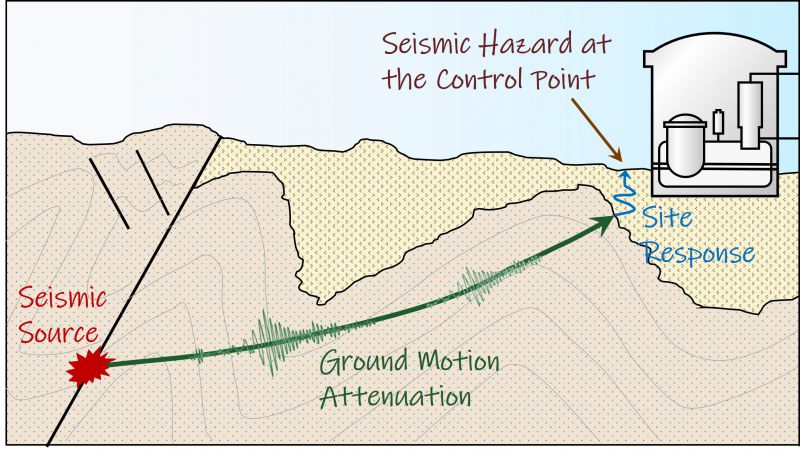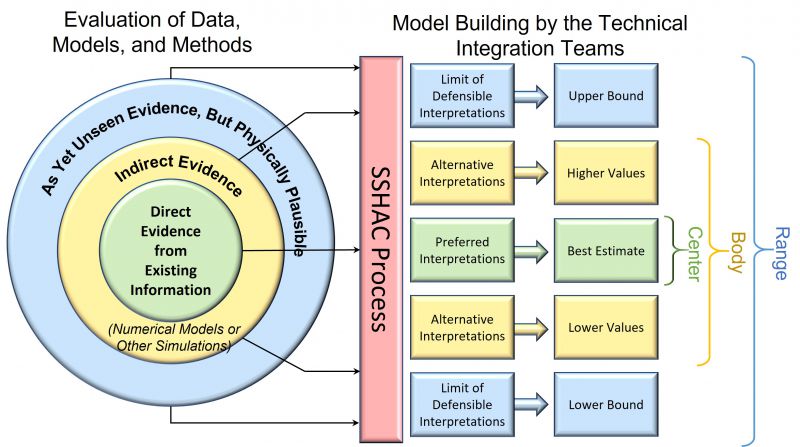Seismic Hazard Analysis (Task 6)
Task Overview
Objective
The objective of this task is to develop seismic hazard curves associated with the plant site.
Purpose
A seismic hazard curve presents the annual frequency (or rate) of exceedance for different values of a selected ground motion parameter (acceleration, velocity, and so on). Hazard curves, which are used as input data in an SPRA, are the final output of a PSHA (probabilistic seismic hazard analysis) representing the mean annual rate of exceedance for the selected motion parameter and the associated uncertainty of this rate at a particular site.
Guidance
As shown in Figure 6-1, the site-specific seismic hazard, as depicted in the figure below, is the combination of three elements.
- Seismic source characterization describing earthquake source rates, magnitudes, and locations
- Ground motion attenuation characterizing the site ground motion based on the earthquake sources (magnitude, style-of-faulting), the wave propagation (distance), and a general site response (site class or Vs30)
- Site response characterization providing site response functions that account for the site-specific response of the soils below the plant
Seismic sources are typically identified as fault sources or area sources. Fault sources are at identified locations where there are rock fractures or a zone of rock fractures that are known to produce earthquakes. In a seismic source model, they are identified with locations, and a probabilistic distribution of expected magnitudes and recurrence rates. Area sources are regions where earthquake can occur with without defined faults. These area sources are also characterized with a location, or geometric area and a probabilistic distribution of expected magnitudes and recurrence rates.
Seismic ground motion models characterize how earthquake vibrations decay (attenuate) with distance as they travel through rock from the hypocenter to the nuclear plant site. The model also characterizes the resulting ground motion amplitudes (e.g., accelerations), given a specific earthquake magnitude. The ground motion models are also characterized as probabilistic distributions.
A site response model characterizes how the vibrations propagate through the local soils, amplifying or attenuating the motions. These models are developed using site investigations that study the types of soils at the site using bore holes to extract vertical columns of soil as well as various types of vibration propagation measurements. In some studies, the seismic sources are combined with the ground motion model to produce a rock hazard and then the rock hazard is amplified by the site response functions. In more recent studies, the site response is combined with the seismic sources and ground motion model in a composite calculation.
Seismic hazard analyses frequently involve a combination of a number of hazard experts and a variety of potential interpretations. These interactions are frequently performed using a process developed by the Senior Seismic Hazard Analysis Committee (SSHAC) in NUREG/CR-6372, Recommendations for Probabilistic Seismic Hazard Analysis: Guidance on Uncertainty and Use of Experts. The goal of the SSHAC process is to determine the center, body, and range (CBR) of the technically defensible interpretations (TDI), as depicted in Figure 6-2 from NUREG-2213, Updated Implementation Guidelines for SSHAC Hazard Studies.
Supplemental Guidance
Related Element of ASME/PRA Standard
Part 5, Seismic Hazard Analysis (SHA)
EPRI Guidance
CEUS Ground Motion Project Final Report, (1009684)
Program on Technology Innovation: Truncation of the Lognormal Distribution and Value of the Standard Deviation for Ground Motion Models in the Central and Eastern United States, (1013105)
Central and Eastern United States Seismic Source Characterization for Nuclear Facilities, (EPRI 1021097 / NUREG-2115 / DOE/NE-0140)
Seismic Evaluation Guidance: Screening, Prioritization and Implementation Details (SPID) for the Resolution of Fukushima Near-Term Task Force Recommendation 2.1: Seismic, (1025287)
Central and Eastern United States Seismic Source Characterization for Nuclear Facilities: Review for Reservoir-Induced Seismicity (RIS) in the Southeast and Earthquakes in South Carolina Near the 1886 Charleston Earthquake, (3002005288)
Central and Eastern United States Seismic Source Characterization for Nuclear Facilities: Maximum Magnitude Distribution Evaluation, (3002005684)
EPRI (2004, 2006) Ground-Motion Model (GMM) Review Project, (3002000717)
Seismic Hazard Research: Kappa and High-Frequency Ground Motion Effects at Hard-Rock Sites, (3002020750)
Other Guidance
NUREG/CR-6372, Recommendations for Probabilistic Seismic Hazard Analysis: Guidance on Uncertainty and Use of Experts
NUREG/CR-6728, Technical Basis for Revision of Regulatory Guidance on Ground Motions: Hazard- and Risk-consistent Ground Motion Spectra Guidelines
Regulatory Guide 1.208, A Performance-Based Approach to Define the Site-Specific Earthquake Ground Motion NUREG-2213, Updated Implementation Guidelines for SSHAC Hazard Studies
Pacific Earthquake Engineering Research Center (PEER) 2018/08, Central and Eastern North America Ground-Motion Characterization: NGA-East Final Report

